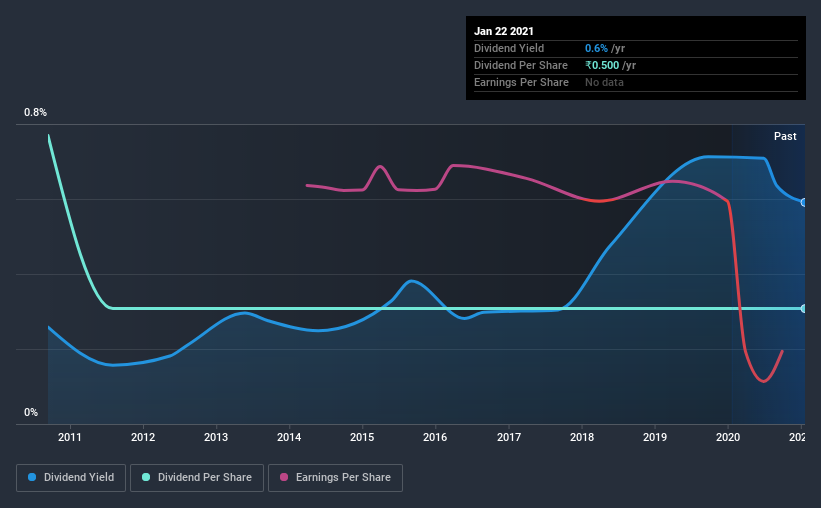- India
- /
- Energy Services
- /
- NSEI:JINDRILL
Does Jindal Drilling & Industries Limited (NSE:JINDRILL) Have A Place In Your Dividend Stock Portfolio?
Today we'll take a closer look at Jindal Drilling & Industries Limited (NSE:JINDRILL) from a dividend investor's perspective. Owning a strong business and reinvesting the dividends is widely seen as an attractive way of growing your wealth. On the other hand, investors have been known to buy a stock because of its yield, and then lose money if the company's dividend doesn't live up to expectations.
A 0.6% yield is nothing to get excited about, but investors probably think the long payment history suggests Jindal Drilling & Industries has some staying power. Some simple analysis can reduce the risk of holding Jindal Drilling & Industries for its dividend, and we'll focus on the most important aspects below.
Explore this interactive chart for our latest analysis on Jindal Drilling & Industries!

Payout ratios
Dividends are typically paid from company earnings. If a company pays more in dividends than it earned, then the dividend might become unsustainable - hardly an ideal situation. Comparing dividend payments to a company's net profit after tax is a simple way of reality-checking whether a dividend is sustainable. While Jindal Drilling & Industries pays a dividend, it reported a loss over the last year. When a company is loss-making, we next need to check to see if its cash flows can support the dividend.
Unfortunately, while Jindal Drilling & Industries pays a dividend, it also reported negative free cash flow last year. While there may be a good reason for this, it's not ideal from a dividend perspective.
Consider getting our latest analysis on Jindal Drilling & Industries' financial position here.
Dividend Volatility
From the perspective of an income investor who wants to earn dividends for many years, there is not much point buying a stock if its dividend is regularly cut or is not reliable. Jindal Drilling & Industries has been paying dividends for a long time, but for the purpose of this analysis, we only examine the past 10 years of payments. Its dividend payments have declined on at least one occasion over the past 10 years. During the past 10-year period, the first annual payment was ₹1.3 in 2011, compared to ₹0.5 last year. The dividend has shrunk at around 8.8% a year during that period. Jindal Drilling & Industries' dividend has been cut sharply at least once, so it hasn't fallen by 8.8% every year, but this is a decent approximation of the long term change.
We struggle to make a case for buying Jindal Drilling & Industries for its dividend, given that payments have shrunk over the past 10 years.
Dividend Growth Potential
Given that dividend payments have been shrinking like a glacier in a warming world, we need to check if there are some bright spots on the horizon. Over the past five years, it looks as though Jindal Drilling & Industries' EPS have declined at around 56% a year. With this kind of significant decline, we always wonder what has changed in the business. Dividends are about stability, and Jindal Drilling & Industries' earnings per share, which support the dividend, have been anything but stable.
Conclusion
When we look at a dividend stock, we need to form a judgement on whether the dividend will grow, if the company is able to maintain it in a wide range of economic circumstances, and if the dividend payout is sustainable. Jindal Drilling & Industries' dividend is not well covered by free cash flow, plus it paid a dividend while being unprofitable. Earnings per share are down, and Jindal Drilling & Industries' dividend has been cut at least once in the past, which is disappointing. Using these criteria, Jindal Drilling & Industries looks quite suboptimal from a dividend investment perspective.
Companies possessing a stable dividend policy will likely enjoy greater investor interest than those suffering from a more inconsistent approach. At the same time, there are other factors our readers should be conscious of before pouring capital into a stock. For example, we've identified 4 warning signs for Jindal Drilling & Industries (2 are potentially serious!) that you should be aware of before investing.
We have also put together a list of global stocks with a market capitalisation above $1bn and yielding more 3%.
If you’re looking to trade Jindal Drilling & Industries, open an account with the lowest-cost* platform trusted by professionals, Interactive Brokers. Their clients from over 200 countries and territories trade stocks, options, futures, forex, bonds and funds worldwide from a single integrated account. Promoted
New: Manage All Your Stock Portfolios in One Place
We've created the ultimate portfolio companion for stock investors, and it's free.
• Connect an unlimited number of Portfolios and see your total in one currency
• Be alerted to new Warning Signs or Risks via email or mobile
• Track the Fair Value of your stocks
This article by Simply Wall St is general in nature. It does not constitute a recommendation to buy or sell any stock, and does not take account of your objectives, or your financial situation. We aim to bring you long-term focused analysis driven by fundamental data. Note that our analysis may not factor in the latest price-sensitive company announcements or qualitative material. Simply Wall St has no position in any stocks mentioned.
*Interactive Brokers Rated Lowest Cost Broker by StockBrokers.com Annual Online Review 2020
Have feedback on this article? Concerned about the content? Get in touch with us directly. Alternatively, email editorial-team (at) simplywallst.com.
About NSEI:JINDRILL
Jindal Drilling & Industries
Engages in providing drilling and related services to the oil and gas exploration companies in India.
Flawless balance sheet with solid track record and pays a dividend.
Market Insights
Community Narratives




